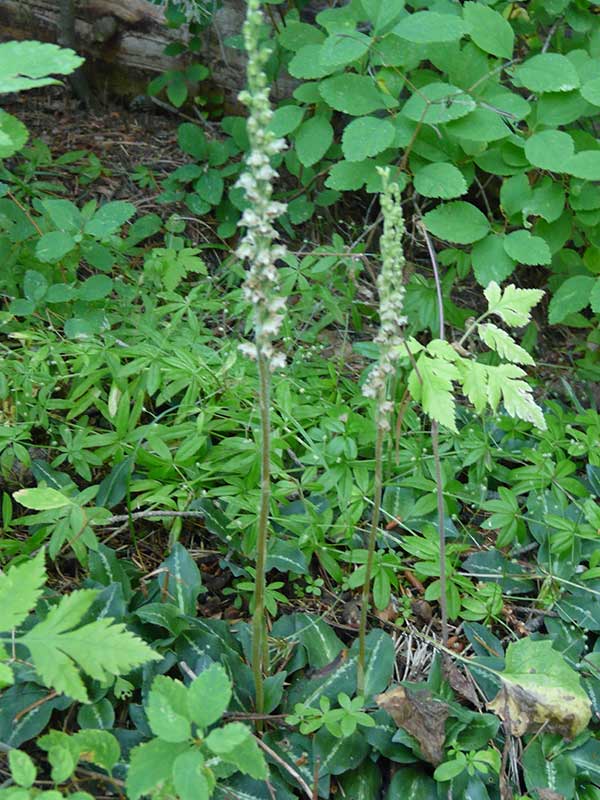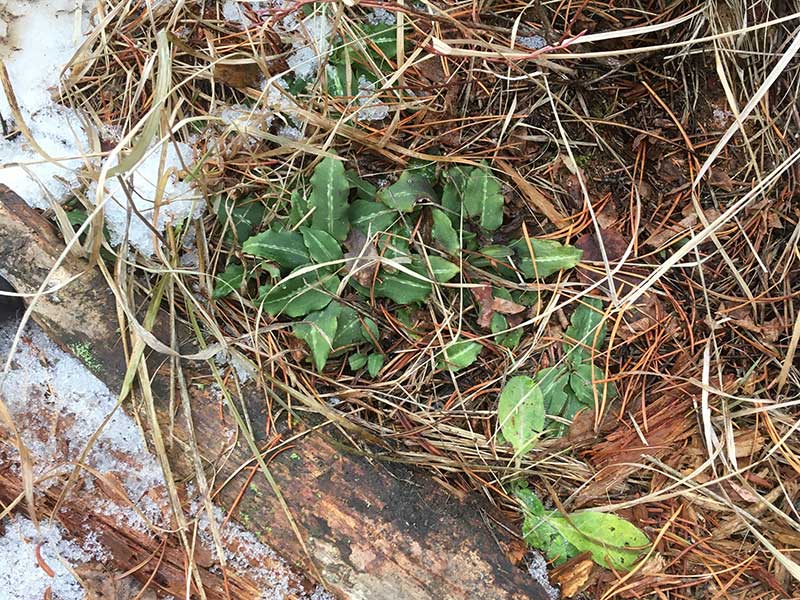Goodyera oblongifolia / western rattlesnake plantain
- basal rosette of blue-green leaves with a white midvein
- single, leafless inflorescence stem
- greenish-white, stalkless flowers, often in a spiral
- the flowers have a hood, a short, pouch-like lip, and 2 flaring sepals
- usually found on the floor of coniferous forests
Synonym: Goodyera decipiens
Also known as: giant rattlesnake plantain
Rattlesnake plantain is either rare or common. It’s common because there is a fair amount of it in the Valley, enough to make it an important browse plant for white-tailed deer. But it is also “rare” because its size makes it a bit hard to find. If you are looking, your chances are best if you look on the floor of a coniferous forest.
In any case, the leaves are much more likely to catch your attention than the flowers. There are 3 to 7 of them… blue-green and forming a rosette. Most notably, they have a prominent white stripe down the middle. The rosette persists over the winter, as shown in one of the gallery photos. It may actually be easier to find before and after the snow than during the summer when everything is thriving.
As for the flowers, this orchid produces a single spike or raceme with numerous small, white flowers – up to 30-ish – usually in a spiral. Because the pedicels are twisted, the flowers are actually upside down (respupinate)… like the white bog orchid which is only a very distant relative. Two of the petals and one of the sepals are fused to form a hood over the lip. The inflorescence is, by orchid standards, not all that impressive unless you have a hand lens.
The fruit of the rattlesnake plantain is an erect, pubescent (hairy) capsule. Although it is only about half an inch long, it contains on the order of 500 minute seeds. The seeds are wind dispersed, but despite their numbers, there is no seed banking. So if they don’t germinate pretty soon, they are not much use to the species.
But having germinated, the plants aren’t in a great hurry to do anything else. The first result of germination is a slow-growing protocorm… sort of like a very small potato with very small rhizoids (like roots but without any conductive tissues). Several months later, scale-like leaves develop. In the greenhouse – relatively good conditions compared to the forest understory – it can take up to a year before leaves are present and two and a half years before the plants are fully mature.
Once there is an actual plant there, it is clonal. It has short, creeping rhizomes and thick, fibrous roots that can generate new above ground plants. Indeed, it propagates mostly by these rhizomes.
Rattlesnake plantain is pollinated by insects, especially bumblebees. They work their way from the bottom of the plant (the more mature flowers) to the top. Unlike many orchids, this one produces nectar, thus encouraging insects to make return visits.
| Color | |
|---|---|
| Family | |
| Blossom size | |
| Inflorescence size | |
| Inflorescence type | |
| When? | |
| Where? |





